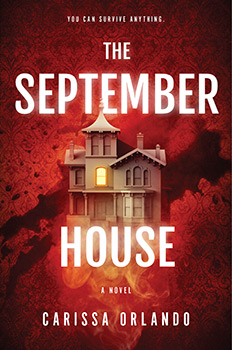About The Villa, author Rachel Hawkins says "there are a lot of stories happening all at once." She describes it as being about friendships and, more specifically, female friendships and toxic relationships. It is also about writing, art, sex and gender, and, or course,
…more money.
The current-day story focuses on Emily, a published author of a cozy mystery series featuring an amateur sleuth named Petal Bloom who lives in a little town called Blossom Bay. Emily is nearly thirty-six years old, still living in Asheville -- the town in which she grew up -- and nothing in her life has been going well for quite some time. She was physically ill for more than a year while a definitive diagnosis and appropriate treatment plan evaded her physicians. Her seven-year marriage to Matt imploded and now she's having trouble focusing on drafting the next installment in the Petal series, "A Gruesome Garden," in part because Petal's love interest, Dex, was modeled on Matt. She needs to finish the book not just to fulfill her contractual obligation. She needs the money to pay her attorneys because her pending divorce has become toxically acrimonious. Matt is suing for a significant portion of her royalties and future earnings, based on Emily's assertion during an interview that the books would not exist without her husband.
Ironically, though, since separating from Matt, Emily's health has improved and she is feeling well enough to meet her childhood friend, Chess Chandler, who is in town for a book signing. The two women were childhood friends -- when Chess was known first as Jessica and, later, Jay -- but rarely see each other. Chess has become a wildly successful self-help guru, publishing books with titles like "You Got This!" Her career began when advice she doled out on a website launched by a friend went viral. Suddenly, Chess amassed hundreds of thousands of Instagram followers, snagged jobs with Salon and the Cut, and landed a book deal. "Things My Mama Never Taught Me" (Chess did not have a good relationship with her mother, Nanci) became an instant bestseller, with Chess telling woman how to get their lives on the "Powered Path" and chatting with Oprah about it. In her first-person narrative, Emily admits that "somewhere around the time she started calling herself 'Chess,' I realized I might actually hate my best friend." Part of the reason may be that Emily's life is decidedly "not on the Powered Path."
Still, Emily agrees to meet Chess for lunch, and they fall back into their old dynamic. And, as always, Chess has a plan. She wants Emily to accompany her to Italy to stay at the sumptuous Villa Aestas just outside Orvieto for six weeks, during which they will work on their respective upcoming books. Emily can't resist the pull of six weeks away from her house and the rut she is in. "Six weeks to try and get my career back on track and reignite my sense of purpose." Of course, since the setting is gorgeous, she can also post beautiful photos on Instagram and Facebook that Matt will see. Chess is feeling pressured by her publisher to come up with her next volume of pithy advice for the masses.
Hawkins employs a parallel narrative focused on Mari Godwick, the author of "Lilith Rising," which was a publishing phenomenon in 1976. Mari was barely out of her teens when she joined the ranks of mostly male writers with the story of a girl named Victoria Stuart who "brings about the destruction of those she loves with no regret, single-minded in her focus in the way teenage girls certainly are in real life, but had not been permitted to be in the realms of horror fiction." By the time the book was released, Mari, inspired by Mary Shelley, who wrote Frankenstein, was already famous -- or perhaps, more aptly, infamous -- because of a tragedy that occurred at Villa Rosato (the prior name of Villa Aestas) during the summer of 1974. Mari traveled there with Pierce Sheldon, her would-be rock star boyfriend, as well as her stepsister, Lara Larchmont, as guests of Noel Gordon, a legitimate Scottish rock star and one of Pierce's idols, modeled after Lord Byron. Also staying at Villa Rosato is Johnnie Dorchester, whose relationship with Noel is murky, at best. At only twenty-six years old, Noel is the senior member of the group. Pierce is twenty-three and Johnnie is twenty, but Mari and Lara are only nineteen years old. And Mari, in particular, the daughter of literary royalty, has already experienced life events normally reserved for adults.
By interspersing excerpts from various articles and podcasts, Hawkins reveals some of the events that took place in 1974. The technique is highly effective, enticing readers to forge on in order to learn how and why those events unfolded. Hawkins has gathered an eclectic and multi-layered group of characters at Villa Rosato. Noel is an established star who has too much money and time to spend between engagements, so he rents Villa Rosato to keep the party going all summer. Purportedly, he and Pierce are there to compose songs together -- the chance to work with Noel could bring Pierce the career breakthrough he has been seeking. But as the weeks go on, not much music gets made, and Mari is increasingly frustrated. Her life with Pierce is supposed to be about the two of them pursuing their art -- his music and her writing. But art cannot be the focus of one's life when money needs to be made in order to survive. Drugs, and sexual experimentation and dalliances cause jealousy, resentments, and distrust, as Johnnie's purpose there gradually becomes clearer, along with his feelings about the other guests. Hawkins says that creating the character of Pierce was the most challenging aspect of drafting The Villa because she had to make him "appealing enough that we understand why both Mari and Lara loved him while also showing just how destructive and oblivious he could be . . ." Indeed, Pierce is both endearingly confused about his life and choices, and despicably self-centered and callous.
The most intriguing aspect of the storyline is Mari's journey, as she navigates her relationships with her housemates and ponders her future, while taking inspiration for the novel that will become her masterpiece from the villa itself, along with snippets of prose that come to her. "Houses remember. She has no idea where she's going with that thought, but it had popped into her brain and she's written it down, sure it was the beginning of . . . something. Something big, some story just sitting coiled inside of her, ready to spring out fully formed." She wants to focus on her writing and tell the story that she can feel taking shape in her imagination. Lara lurks on the edges of the group, craving attention. She has a history with and feelings for Pierce, and Mari does not trust her. Indeed, she and the others find Lara's cloying attempts to be noticed and desire for validation annoying. But Lara and Mari have been inextricably intertwined for years, and their bond grows stronger during that revelatory and life-changing summer.
In the present day, Emily is inspired to write, as well. But she has no interest in continuing Petal Bloom's story. Rather, she learns about the villa's notorious history and begins researching what happened. Like Mari's, her search proves consequential in a variety of ways. Emily, like Mari, is a fully developed character and her emotional struggle is palpable. She is well aware that she has arrived at a crossroads in her life, and is determined to carve out a happier future for herself. She is also intent on keeping Chess from co-opting her impending success. Like the relationship of Mari and Lara, Emily's long friendship with Chess is complicated and riddled with old hurts, resentments, jealousy, and distrust. Secrets and betrayals are revealed. But they are bound together through history and shared experiences, and neither of them has the desire -- or strength -- to completely untangle their relationship. As Hawkins details the history of their friendship, she reveals that Emily has always been more naive and gullible than Chess, who has parlayed her natural wit and charisma into an empire. Emily knows the real Chess, rather than the one who inspires other women to buy her psychobabble-laden advice. But Emily is not guileless and as she delves further into the history of the villa and its former visitors, the inherent unreliability in her narrative becomes apparent. Is Emily a hapless victim of others' manipulations or does she have a dark nature, as well? Can her friendship with Chess withstand bombshell revelations and calculated machinations? Should it? The story's pace never stalls as Hawkins injects surprising twists at perfectly timed intervals.
The Villa seamlessly combines two evocative storylines set nearly five decades apart but with eerie parallels. Hawkins examines artistry and the mysterious genesis of inspiration, as well as the mercurial nature of friendships and the destructive power of toxic relationships. Hawkins relates that she was inspired to explore "the idea of how art and life intersect, how great art can get made in the middle of chaos and the way artists inspire and also possibly derail one another." And she does so in an absorbing, suspenseful and, ultimately, entertaining mystery.
Thanks to NetGalley for an Advance Reader's Copy of the book. (less)

























.png)